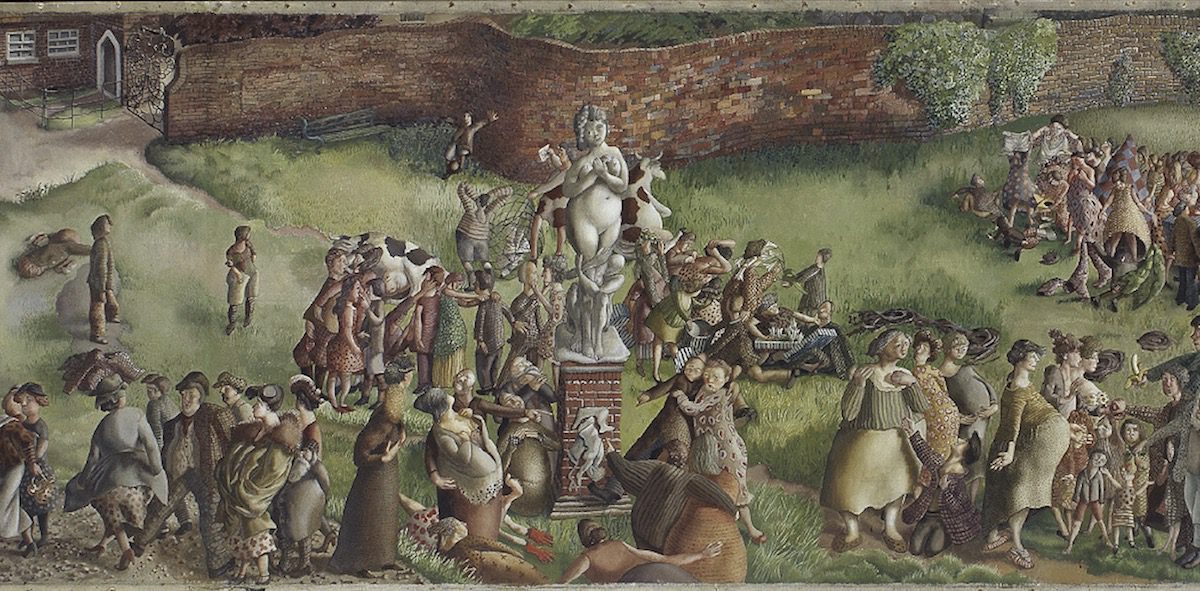A new exhibition at the popular Stanley Spencer Gallery in Cookham titled Patron Saints: Collecting Stanley Spencer, opens later this month. Spencer’s spiritual home and major source of inspiration is featured in many of the works. The exhibition draws together a spectacular collection of loans, including The Centurion’s Servant, Tate; Love on the Moor, Fitzwilliam; John Donne Arriving in Heaven, Fitzwilliam and one work not seen in the public domain in over 50 years.
The exhibition will examine the often complex relationships between Spencer and his patrons and what drove them to collect his work.
Spencer was a single-minded genius, but the influence of his patrons on his painting is far greater than has hitherto been realised.
At the turn of the century, collecting art was no longer the preserve of the aristocracy and the upper classes, but Spencer’s art appealed to a broad spectrum of art lovers, fellow artists, businessmen and politicians. Many of his patrons lived in Cookham, where he lived and found artistic inspiration, and many of his paintings were influenced by his spiritual feelings for that place. His idiosyncratic and deeply personal approach gave him a wide and enduring appeal, and he was patronised by some of the most important cultural figures and taste-makers of that time.

Sarah Tubb and the Heavenly Visitors, 1933 by Sir Stanley Spencer
Curator Amanda Bradley comments, Behind Stanley Spencer, one of the greatest Modern British artists, were a group of individuals who enabled his very existence – both artistically and emotionally. They were not wildly rich, but they were powerful, cultivated, intellectual and artistic. Some bought on spec, others were true patrons, giving him the freedom to fulfil his artistic genius. Most fostered long-lived relationships with the artist, influencing his life and work more than has hitherto been realised. These were the patron saints.
The historically grounded exhibition will explore the emergence of Spencer as an artistic personality, looking at those who helped him and why he – and his popularity – was a product of the zeitgeist (first half of the twentieth century) characterised by social and economic anxiety.
Sir Stanley Spencer CBE RA (30 June 1891 – 14 December 1959) was an English painter. Shortly after leaving the Slade School of Art, Spencer became known for his paintings depicting Biblical scenes occurring as if in Cookham, the small village beside the River Thames where he was born and spent much of his life. Spencer referred to Cookham as “a village in Heaven” and in his biblical scenes, fellow-villagers are shown as their Gospel counterparts. Spencer was skilled at organising multi-figure compositions such as in his large paintings for the Sandham Memorial Chapel and the Shipbuilding on the Clyde series, the former being a First World War memorial while the latter was a commission for the War Artists’ Advisory Committee during the Second World War.
As his career progressed Spencer often produced landscapes for commercial necessity and the intensity of his early visionary years diminished somewhat while elements of eccentricity came more to the fore. Although his compositions became more claustrophobic and his use of colour less vivid he maintained an attention to detail in his paintings akin to that of the Pre-Raphaelites.[1] Spencer’s works often express his fervent if unconventional Christian faith.
Top Photo: Stanley Spencer Love on the Moor (Detail) © Stanley Spencer Estate
Patron Saints: Collecting Stanley Spencer – Stanley Spencer Gallery, 16 High Street, Cookham, Maidenhead SL6 9SJ Thursday 29th March – Sunday 4th November 2018

